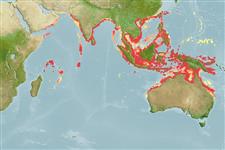>
Gobiiformes (Gobies) >
Gobiidae (Gobies) > Gobiinae
Etymology: Acentrogobius: Greek, a = without + Greek, kentron = sting + Latin gobius = gudgeon (Ref. 45335).
More on author: Valenciennes.
Environment: milieu / climate zone / distribuzione batimetrica / distribution range
Ecologia
marino; acqua dolce; salmastro demersale; amfidromo (Ref. 46888). Tropical; 26°N - 27°S, 51°E - 135°W
Indo-West Pacific. Freshwater records from Madagascar by Pellegrin were based on juveniles of unidentified species (Ref. 4343).
Size / Peso / Age
Maturità: Lm ? range ? - ? cm
Max length : 18.3 cm TL maschio/sesso non determinato; (Ref. 122101); peso massimo pubblicato: 51.60 g (Ref. 122101)
Short description
Chiavi di identificazione | Morfologia | Morfometria
Spine dorsali (totale) : 6 - 7; Raggi dorsali molli (totale) : 9 - 10; Spine anali: 1; Raggi anali molli: 9. Characterized by pale grey body with five diffuse brown saddles along back; midside with 4-5 diffuse brown blotches; head and body with scattered white spots; presence of diagnostic greenish patch behind upper edge of operculum; rounded caudal fin; longitudinal scale series 25-26; scales absent on head except upper half of opercle and predorsal fully scaled; mainly ctenoid body scales; depth of body 5.3 in SL (Ref. 90102).
Body shape (shape guide): elongated; Cross section: circular.
Occur along coastlines and in estuaries and harbors. Usually found in brackish tidal waters. Feed on invertebrates. Found to contain tetrodotoxin (TTX) and anhydrotetrodotoxin (anh-TTX) which causes paralytic food poisoning (Ref. 54777). Marketed fresh in Mekong delta (Ref. 12693).
Life cycle and mating behavior
Maturità | Riproduzione | Deposizione | Uova | Fecundity | Larve
Maugé, L.A., 1986. Gobiidae. p. 358-388. In J. Daget, J.-P. Gosse and D.F.E. Thys van den Audenaerde (eds.) Check-list of the freshwater fishes of Africa (CLOFFA). ISNB, Brussels; MRAC, Tervuren; and ORSTOM, Paris. Vol. 2. (Ref. 4343)
IUCN Red List Status (Ref. 130435: Version 2024-2)
Threat to humans
Poisonous to eat (Ref. 54777)
Human uses
Strumenti
Special reports
Download XML
Fonti Internet
Estimates based on models
Preferred temperature (Fonte Biblio.
123201): 25.1 - 29, mean 28.2 °C (based on 1000 cells).
Phylogenetic diversity index (Fonte Biblio.
82804): PD
50 = 0.5000 [Uniqueness, from 0.5 = low to 2.0 = high].
Bayesian length-weight: a=0.00871 (0.00552 - 0.01374), b=3.07 (2.95 - 3.19), in cm total length, based on LWR estimates for this species & Genus-body shape (Ref.
93245).
Trophic level (Fonte Biblio.
69278): 3.5 ±0.37 se; based on food items.
Resilienza (Fonte Biblio.
120179): Medio, tempo minimo di raddoppiamento della popolazione 1.4 - 4.4 anni (Preliminary K or Fecundity.).
Fishing Vulnerability (Ref.
59153): Low vulnerability (10 of 100).
🛈
